With eyes wide open and all senses alert, eight Maremmano sheepdogs stand guard watching over 400 sheep, scouring the Italian hillside for any sight or smell of marauding wolves. Their job is to protect the sheep against attack from the predatory packs that have been reintroduced onto European soils, a move that has greatly angered livestock farmers.
While the aggressor enjoys national protection by European Union regulations, meaning they cannot be touched, wolf numbers have now swollen to over 20,000 on the continent. Sheep farmer Gabriele Filippini is on constant alert as he tends to his 400 milking ewes that reside on a steep incline in the Tor di Monte area, near Orvieto, central Italy.
Eyes and ears
The famous breed of sheepdogs are his eyes and ears, day and night. Prior to having the dogs Gabriele lost 90 sheep to the wolves over a five-year period, a loss that wasn’t easy to accept.
Nowadays, the wolves still strike taking around five sheep per year, but this would be much higher if it were not for the guard dogs.
Gabriele said: “We milk 400 ewes twice per day in mobile units producing around 500 litres of milk per day. Our milk is cool stored for three days before it is collected by the Caseificio Matteassi Onelio processor to make the famous Pecorino cheese.
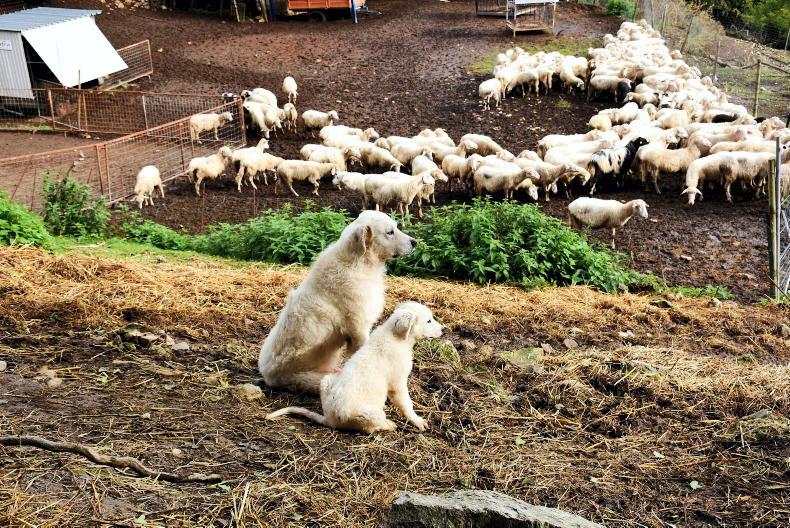
Five month old Maremmano pup Storm and five year old Bobby keep watch out for wolves on Gabriele’s farm at Tor di Monte, Italy. PHOTO: Chris McCullough
“The sheep have access to 290 hectares, 100 hectares of which is mountainous, 50 hectares of forest and the remainder in meadows. There are a few wolves roaming this region, therefore we need the dogs to guard the sheep,” he said.
Gabriele’s sheep are the Sarda breed which originated in Sardinia and are very popular throughout Italy and Tunisia for producing milk. They are quite versatile sheep able to handle both lowland or mountainous terrains. And it is in these areas that the guard dogs have to be extra vigilant for wolf attacks.
Maremmano dogs
The Maremmano dog breed is indigenous to central Italy, especially to the Maremma region of Tuscany and Lazio, and also the Abruzzo region in southern Italy. Dating back to 1898, the Maremmano, also called the Abruzzese breed, has a solid, muscular build, a thick white coat, a large head and a black nose.
The males can weigh up to 45kg and stand up to 73cm at the shoulder, while females are smaller at 60cm to 68cm, weighing 30 to 40kg.
Gabriele introduces the dogs to the sheep as puppies so they can bond with them and become their guardians. Right now he has a five-month-old pup called Storm, who likes to follow Bobby, one of the bigger five-year-old males, around the farm.
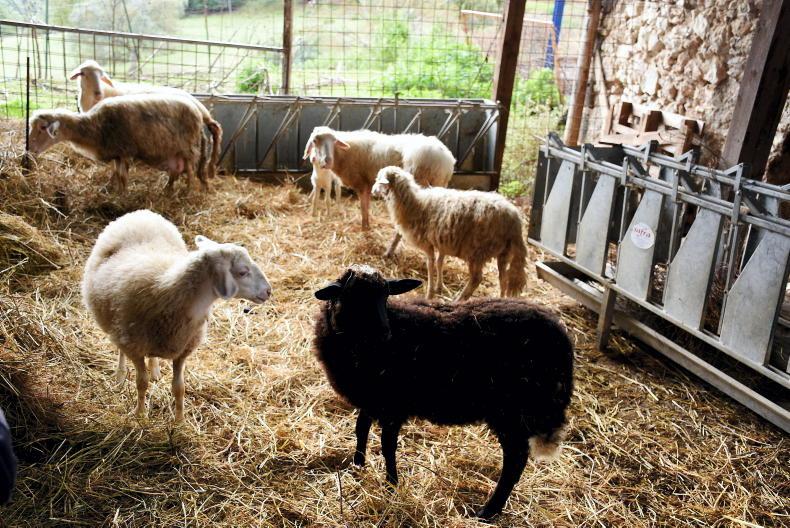
Gabriele’s Sarda sheep have their first lamb at 15 months old. / Chris McCullough
Gabriele said: “The dogs really do their job well. I have seen wolves on the farm but the dogs are always on guard. They know what to do. “During the day the sheep roam through the meadows and the forests, but after milking in the evening we keep them in caves under our 13th century Tordimonte Castle, which is part of our family’s property.
“The views at the top of our farm where we milk the sheep are breathtaking, looking over the Paglia River Valley. However, without the dogs we could not be successful with the sheep,” he said.
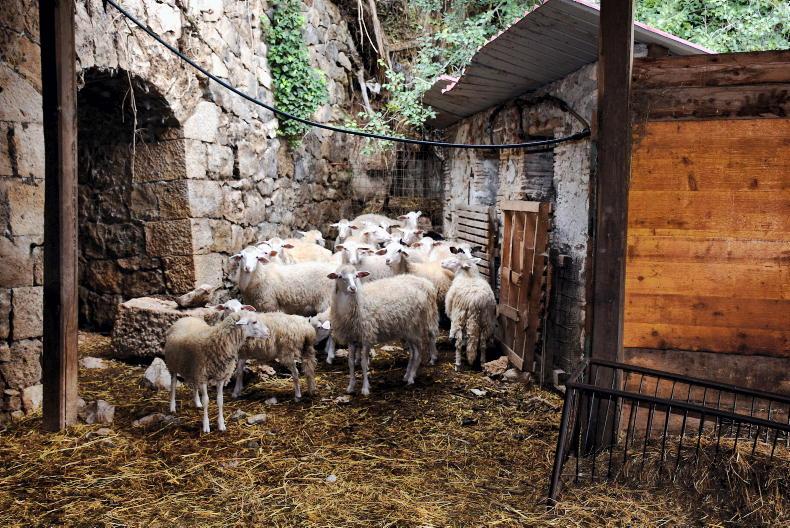
The sheep are held in underground caves at night time to protect them from wolf attacks. PHOTO: Chris McCullough
Gabriele works on the farm with the help of his wife Elmira, and one other seasonal worker. Looking after so many sheep is hard work but with the Sarda breed being good mothers, the workload is eased somewhat.
Production system
Gabriele said: “Our Sarda sheep have their first lamb born at around 15 months old, mostly around November to December and in the spring time. They normally have two lambs each per year.
“All the females are kept for breeding and the males are mostly sold to butchers for meat, with a few sold for breeding. “Every three years we refresh the male genetics used on our flock to give us better breeding sheep,” added Gabriele.
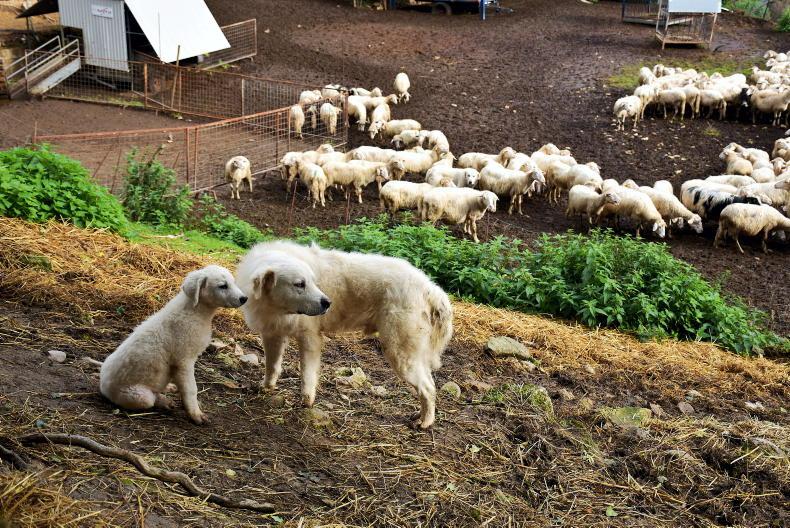
Five month old Maremmano pup Storm and five year old Bobby keep watch out for wolves on Gabriele’s farm at Tor di Monte, Italy. PHOTO: Chris McCullough
Overproduction of sheep milk in the Umbria region means that the price Gabriele receives for his milk is decreasing. While the Sarda sheep milk is of high quality at 5% protein and 7-8% butterfat, it, too, has experienced a price hit.
Gabriele said: “Five years ago we were receiving €1.60 per litre, but because there is currently too much sheep milk in the region the price is now down to 70 cents per litre. Our costs are getting higher too. Due to the climate change we are hit by droughts in this area, which is affecting our fodder harvest. Normally we could take a cut of hay around May or June but because of the dry weather and slow growth it is July before we can manage the harvest.

Gabriele’s sheep are milked twice per day up on the hillside overlooking the Paglia River Valley. PHOTO: Chris McCullough
“It’s the same story with the cereals we grow as their yields are also down forcing us to buy in feed and fodder at increased rates,” he said. With the production of sheep milk accounting for 75% of Gabriele’s income, he is relying on his team of dogs to keep the wolves at bay without suffering heavy losses.
* Chris McCullough is a journalist and photographer based in Northern Ireland
Wolves in Europe
There are over 20,000 wolves in continental Europe. Approximately 3,300 of these can be found in Italy, mainly in mountain regions.
Each year wolves kill around 65,000 livestock, mostly sheep, across Europe. It is not uncommon for Italian farmers who are affected to lose 3% to 4% of their sheep to wolves each year.
In short
Increasing wolf numbers are becoming a growing concern for farmers across many regions in Europe. Italian sheep farmer Gabriele Filippini uses Maremmano dogs to protect his 400 head sheep flock. With sheep milk prices under pressure minimising losses from wolves is critical for the Filippini family. 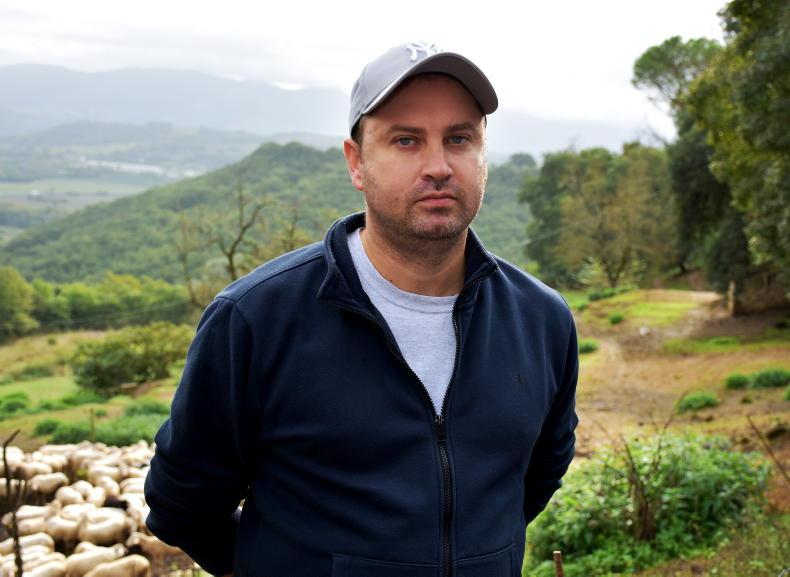
Gabriele Filippini milks 400 sheep on his farm close to Orvieto in Italy. / Chris McCullough
With eyes wide open and all senses alert, eight Maremmano sheepdogs stand guard watching over 400 sheep, scouring the Italian hillside for any sight or smell of marauding wolves. Their job is to protect the sheep against attack from the predatory packs that have been reintroduced onto European soils, a move that has greatly angered livestock farmers.
While the aggressor enjoys national protection by European Union regulations, meaning they cannot be touched, wolf numbers have now swollen to over 20,000 on the continent. Sheep farmer Gabriele Filippini is on constant alert as he tends to his 400 milking ewes that reside on a steep incline in the Tor di Monte area, near Orvieto, central Italy.
Eyes and ears
The famous breed of sheepdogs are his eyes and ears, day and night. Prior to having the dogs Gabriele lost 90 sheep to the wolves over a five-year period, a loss that wasn’t easy to accept.
Nowadays, the wolves still strike taking around five sheep per year, but this would be much higher if it were not for the guard dogs.
Gabriele said: “We milk 400 ewes twice per day in mobile units producing around 500 litres of milk per day. Our milk is cool stored for three days before it is collected by the Caseificio Matteassi Onelio processor to make the famous Pecorino cheese.

Five month old Maremmano pup Storm and five year old Bobby keep watch out for wolves on Gabriele’s farm at Tor di Monte, Italy. PHOTO: Chris McCullough
“The sheep have access to 290 hectares, 100 hectares of which is mountainous, 50 hectares of forest and the remainder in meadows. There are a few wolves roaming this region, therefore we need the dogs to guard the sheep,” he said.
Gabriele’s sheep are the Sarda breed which originated in Sardinia and are very popular throughout Italy and Tunisia for producing milk. They are quite versatile sheep able to handle both lowland or mountainous terrains. And it is in these areas that the guard dogs have to be extra vigilant for wolf attacks.
Maremmano dogs
The Maremmano dog breed is indigenous to central Italy, especially to the Maremma region of Tuscany and Lazio, and also the Abruzzo region in southern Italy. Dating back to 1898, the Maremmano, also called the Abruzzese breed, has a solid, muscular build, a thick white coat, a large head and a black nose.
The males can weigh up to 45kg and stand up to 73cm at the shoulder, while females are smaller at 60cm to 68cm, weighing 30 to 40kg.
Gabriele introduces the dogs to the sheep as puppies so they can bond with them and become their guardians. Right now he has a five-month-old pup called Storm, who likes to follow Bobby, one of the bigger five-year-old males, around the farm.

Gabriele’s Sarda sheep have their first lamb at 15 months old. / Chris McCullough
Gabriele said: “The dogs really do their job well. I have seen wolves on the farm but the dogs are always on guard. They know what to do. “During the day the sheep roam through the meadows and the forests, but after milking in the evening we keep them in caves under our 13th century Tordimonte Castle, which is part of our family’s property.
“The views at the top of our farm where we milk the sheep are breathtaking, looking over the Paglia River Valley. However, without the dogs we could not be successful with the sheep,” he said.

The sheep are held in underground caves at night time to protect them from wolf attacks. PHOTO: Chris McCullough
Gabriele works on the farm with the help of his wife Elmira, and one other seasonal worker. Looking after so many sheep is hard work but with the Sarda breed being good mothers, the workload is eased somewhat.
Production system
Gabriele said: “Our Sarda sheep have their first lamb born at around 15 months old, mostly around November to December and in the spring time. They normally have two lambs each per year.
“All the females are kept for breeding and the males are mostly sold to butchers for meat, with a few sold for breeding. “Every three years we refresh the male genetics used on our flock to give us better breeding sheep,” added Gabriele.

Five month old Maremmano pup Storm and five year old Bobby keep watch out for wolves on Gabriele’s farm at Tor di Monte, Italy. PHOTO: Chris McCullough
Overproduction of sheep milk in the Umbria region means that the price Gabriele receives for his milk is decreasing. While the Sarda sheep milk is of high quality at 5% protein and 7-8% butterfat, it, too, has experienced a price hit.
Gabriele said: “Five years ago we were receiving €1.60 per litre, but because there is currently too much sheep milk in the region the price is now down to 70 cents per litre. Our costs are getting higher too. Due to the climate change we are hit by droughts in this area, which is affecting our fodder harvest. Normally we could take a cut of hay around May or June but because of the dry weather and slow growth it is July before we can manage the harvest.

Gabriele’s sheep are milked twice per day up on the hillside overlooking the Paglia River Valley. PHOTO: Chris McCullough
“It’s the same story with the cereals we grow as their yields are also down forcing us to buy in feed and fodder at increased rates,” he said. With the production of sheep milk accounting for 75% of Gabriele’s income, he is relying on his team of dogs to keep the wolves at bay without suffering heavy losses.
* Chris McCullough is a journalist and photographer based in Northern Ireland
Wolves in Europe
There are over 20,000 wolves in continental Europe. Approximately 3,300 of these can be found in Italy, mainly in mountain regions.
Each year wolves kill around 65,000 livestock, mostly sheep, across Europe. It is not uncommon for Italian farmers who are affected to lose 3% to 4% of their sheep to wolves each year.
In short
Increasing wolf numbers are becoming a growing concern for farmers across many regions in Europe. Italian sheep farmer Gabriele Filippini uses Maremmano dogs to protect his 400 head sheep flock. With sheep milk prices under pressure minimising losses from wolves is critical for the Filippini family. 
Gabriele Filippini milks 400 sheep on his farm close to Orvieto in Italy. / Chris McCullough












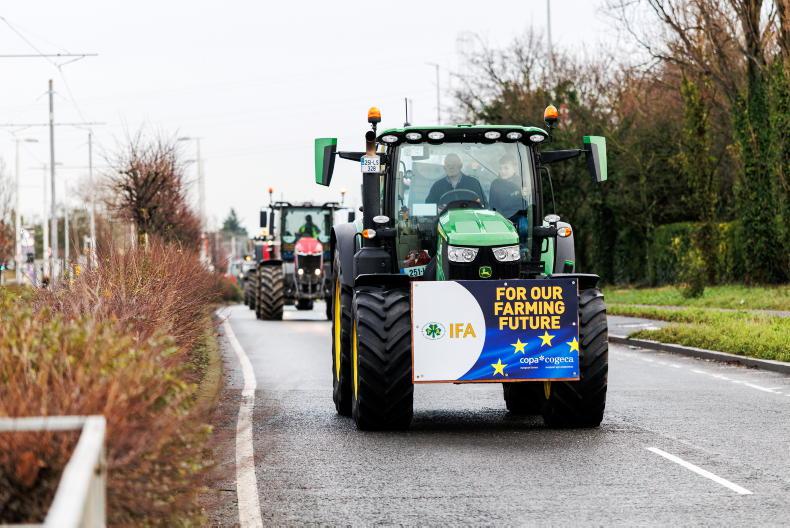
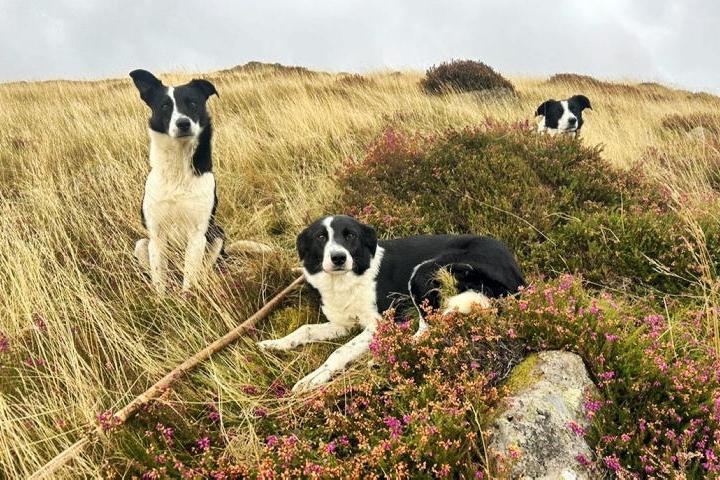

SHARING OPTIONS